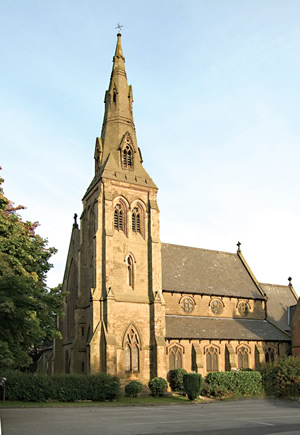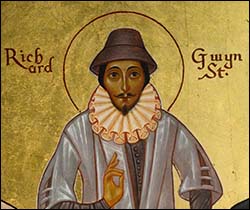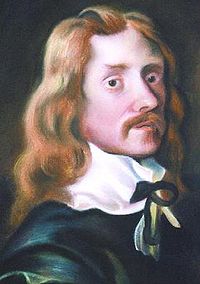Votive Mass of Saint Richard Gwyne, Martyr

The just shall rejoice in the Lord, and shall hope in him (63:11).
Devotion: the Gift of Self
One of the most distinctive characteristics of traditional Catholic piety is, without any doubt, a living devotion to the saints. Devotion is the gift of oneself. Devotion is akin to friendship. One is devoted to one’s friend. The saints, being all ablaze in the love of Christ, are more devoted to us than we to them. The friendship of the saints is a glorious thing. The devotedness of the saints to us is offered gratuitously and is numbered among those «best and perfect gifts from above, descending from the Father of Lights» (James 1:17).
And therefore we also having so great a cloud of witnesses over our head, laying aside every weight and sin which surrounds us, let us run by patience to the fight proposed to us: Looking on Jesus, the author and finisher of faith, who having joy set before him, endured the cross, despising the shame, and now sitteth on the right hand of the throne of God. (Hebrews 12:1–2)
Coming to Know the Saints
Devotion to the saints is, I think, sparked and sustained by some knowledge of their words, their deeds, and even something of the homely details of their lives. One rightly cherishes the images of the saints. One rightly venerates their sacred relics. One rightly goes on pilgrimage to the places sanctified by their presence in life and in death.
 Through the Sacred Liturgy
Through the Sacred Liturgy
There is, however, another way of coming to an intimate knowledge of the saints, a way that transcends, and fulfils, and perfects all that historians and hagiographers can tell us about them. I am speaking, of course, of the sacred liturgy, «the primary and indispensable source of the authentic Christian spirit» (Pope Saint Pius X, Tra le sollecitudini) and, I would add, of the deepest knowledge of the saints. Artists do their best to create portraits of the saints in which some glimmer of the secret of their holiness is perceptible to the eye. Musicians do their best to compose hymns and anthems that evoke the heroism of the saints. Poets and even playwrights do their best to set forth in words the only drama worth living: that of surrender to the fire of divine love.
Sacramental Knowledge
All of these various ways of approaching the saints are praiseworthy but none of them give us, as does the sacred liturgy, an infallibly accurate portrait of the saint; a knowledge of the saint that is not merely anecdotal, or hagiographic, or historical, but sacramental. I should want to say mystical. This sacramental knowledge, this mystical exchange, this sapiential experience of the saints is offered us in the sacred liturgy.
 The Proper of the Mass
The Proper of the Mass
The most authentic portrait of a saint emerges from the Proper of the Mass with its chants, its orations, its Epistle and its Gospel; from the antiphons, lessons, responsories, and hymns of the Divine Office. If then, you would know the glorious martyr Saint Richard Gwyne, and so begin to experience something of his heavenly friendship, attend — attend with the ear of the heart — to the Propers of the Holy Mass in which we are already deeply engaged.
Joy in God and Irrepressible Hope
The Introit, Laetabitur Iustus, calls Saint Richard a just man, a man at peace with God and with his fellows, faithful to his wife, devoted to his children, righteous, and trustworthy, rather like that other prototypical iustus of the liturgy, Saint Joseph. In reading today’s Introit, or better yet, in singing it, we are presented with Richard Gwyne, a man who rejoices in the Lord and hopes in Him. Laetabitur . . . et sperabit.
The just shall rejoice in the Lord, and shall hope in him: and all the upright in heart shall be praised. (Psalm 63:11)
Here is an attractive holiness, one characterised by what I like to call a supernatural optimism: joy in God, and an irrepressible hope. If you would take your place among the upright in heart, the recti corde, then ask Saint Richard to obtain for you something of his own joy, something of his own hope. There is, it seems to me, a dearth of joy and hope among many Catholics today. Not a few of the faithful are inclined to present a grim and dour visage of holiness, not the one that Mother Church sets forth in today’s Introit.
Praying in Loud Cries and Tears
The verse of the Introit is no less important than the antiphon. «Hear, O God, my prayer when I make supplications to Thee; deliver my soul from the fear of the enemy» (Psalm 63:2). Can you not hear Saint
Richard make this cry of the psalmist his own? Why then, would we not make it our own in the chances and changes of life in this valley of tears?
The marvelous thing about the Propers of the Mass is that they give us the very substance of the prayer of the saints. We, by entering into the words of the sacred liturgy, enter into the prayer of the saints, which prayer, uttered here below in «loud cries and tears» (Hebrews 5:7) resounds still in the ear of God, and remains ever efficacious. The psalmist tells us that God stores up every tear shed before him as in a bottle. Monsignor Knox puts it this way: «My wandering life none knows as thou; no tear of mine but thou dost hoard and record it» (Psalm 55:9).
Ready to Do Battle
The Collect describes Saint Richard not only as a schoolmaster of young people, but also as a propugnator Catholicae fidei. Propugnator is a splendid word, usually translated as champion, but having about something that suggests a stalwart ready to do battle. Nothing here of that shrinking subservience to the world that today is, all too often, qualified as openness to dialogue and adaptation to diversity. We are not, all of us, called to be schoolmasters like Saint Richard, but we are called to be stalwarts ready, as Saint Benedict says, «to take up the strong and bright weapons of obedience, in order to fight for the Lord Christ, our true king» (Rule of Saint Benedict, Prologue).
The Epistle, though written by Saint Paul to Timothy, becomes, in the context of today’s Holy Mass, Saint Richard’s words addressed to us. «All that will live godly in Christ Jesus», he says, «shall suffer persecution» (2 Timothy 2:10). One does not come by godly living cheaply. It is a costly affair, and fraught with risks.
When the Just Man Falls
The Gradual is reassuring. It is, I think, like the Epistle, placed in the mouth of Saint Richard. He speaks to us out of his own experience: «When the just man shall fall, he shall not be bruised: for the Lord putteth His hand under him» (Psalm 36:24). Is this not wonderfully consoling? Firstly, the just man falls. «A just man», we read in Proverbs, «shall fall seven times and shall rise again» (Proverbs 24:16). Secondly, when he falls, the Lord is there to put His hand under him.
The Light of Life Eternal
The Alleluia Verse is in the mouth of Christ.
He that followeth Me walketh not in darkness, but shall have the light of life eternal. (John 8:12)
Already, in preparing for the Holy Gospel in which Christ is present in the midst of the Church to speak to her, heart to heart, we hear the voice of Christ introducing what He is about to say. This is the way the sacred liturgy works: one word in the mouth of Our Lord is juxtaposed to another and, in the coincidence of these words sparks are kindled, and a fire blazes up. «Was not our heart burning within us, whilst he spoke in this way?» (Luke 24:32).
Fear Not
In the Gospel, Our Lord, who spoke to Saint Richard Gwyne, speaks now to us. We are to fear God for, into His hands, we shall all fall, by one way or another, body and soul. «It is a fearful thing to fall into the hands of the living God» (Hebrews 10:31). At the same time, the God into whose hands we shall all fall is the same God who, in the Gradual of today’s Mass, puts his hand under us lest, in falling here, we should be mortally bruised hereafter.
He hath given his angels charge over thee; to keep thee in all thy ways. In their hands they shall bear thee up: lest thou dash thy foot against a stone.Thou shalt walk upon the asp and the basilisk: and thou shalt trample under foot the lion and the dragon. (Psalm 90:11–13)
«Fear not therefore», says Our Lord, «My Father who looks even to the flight and fall of the sparrows, looks to you, and nothing shall befall you apart from what He wills or, in his mysterious providence, permits».
Peering into Heaven
The Offertory Antiphon, in anticipation of the holy mysteries, shall pull back the veil for one fleeting moment, allowing us to peer into heaven. And there we shall see Saint Richard and, in a kind of wonderment, sing: «Thou hast crowned him with glory and honour: and hast set him over the works of Thy hands» (Psalm 8:6–7). David here prophesies, first of all, of Christ the King, crowned in the glory of His resurrection and ascension, but he prophesies also concerning all those who belong to Christ. «In crowning their merits», sings a Preface of Patron Saints, «Thou crownest Thine own gifts».
Taking Up the Cross
With the Communion Antiphon, we return to what Saint Benedict calls, «the hard and rugged things by which we walk towards God» (Rule of Saint Benedict, Chapter 58). Again, it is Our Lord Himself who speaks, coming to us in the adorable sacrament of His Body and Blood:
If any man will come after Me, let him deny himself and take up his cross, and follow me. (Matthew 16:24)
The Liturgical Portrait
Here is the final touch on the liturgical portrait of Saint Richard Gywne: the just man; the man of gladsome heart; the man who hoped when all around him conspired to thrust him into despair; the man upheld by the strong and tender hand of God; the man undaunted at the prospect of doing battle for the Catholic faith; the man constant in persecution; the man unafraid to fall into the hands of God; the man crowned in heaven with glory and honour. Saint Richard was all of this because, sustained by the true Body and Blood of Jesus Christ, offered in Sacrifice and given in Holy Communion, he went after Him whom he received, denied Himself, took up his Cross, and followed the Lamb even unto the immolation of a bloody death.
To Behold the Face of Christ
No one of us can follow Saint Richard in the details of his life, such as it has come down to us through his biographers, but each one of us can find in his liturgical portrait the point of resemblance towards which the Holy Ghost would draw us. No one of us will, I should think, reproduce in himself the complete portrait — God does not deal in reproductions, but only in originals — but in each of us that point of resemblance willed by God, that precious bit of family likeness, will, by our participation in the Holy Sacrifice of the Mass become, day by day, stronger, and clearer. At length, with Saint Richard Gwyne, and helped by his intercession, may it be granted us to behold the Face of Christ unveiled and shining in the familiar faces of an innumerable multitude of saints.
